One of the purposes of the Safe Trails Coalition is to address and change unauthorized and unsafe trail activities that threatens public safety and damages our parklands. From creation of new trails (or cutting of switchbacks) down steep slopes or in riparian areas to bushwhacking through sensitive habitats, or ignoring signage for trail rules and trail closures to unacceptable behaviors by park visitors, we collectively decided something needs to be done to address these issues. Our experience has been that uniting our common interests works more effectively than going it alone, hence the formation of the Safe Trails Coalition.
Together we support recreational access (including the creation of more trailheads and trails), but not to the detriment of the safety of other park users, the land, its habitats, or wildlife. Our parks and open spaces are a finite resource that needs to provide safe access for all users and remain protected for generations to come. They are full of rare and special habitats and species, in fact this is the primary reason they are parks and not shopping malls or houses. The Safe Trails Coalition and our many supporters are working to help land managers and park rangers find the balance between recreation in our open spaces and supporting wildlife.
Below are some of the more serious problems land managers are encountering on our trails and in our park systems. Some of these photos include areas outside of Orange County, because these problems are faced by land managers all over the region, state, and country.
| Vandalism of Park Resources and Park Property |
| Some park visitors show a lack of respect for the park resources and park property. These photos depict a few examples of destruction of the natural and park resources, which have a permanent and lasting impact on the park. Paint (graffiti) cannot be removed from the trees and carvings prevent the trees from delivering nutrients to the branches and leaves, likely leading to its death. Under no circumstance is it okay to bring your own equipment and give the trail vegetation a trim. When signs are vandalized it costs land managers time and money to replace them. Since visitors rely on this information, land managers must replace the signs, which can be a costly endeavor. Most land managers rely on tax dollars to manage these natural areas, therefore it is costing each one of us money. (Click on the photo to enlarge) |
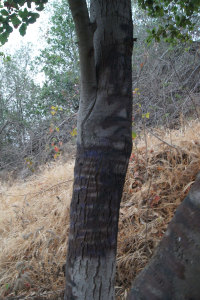
Hacienda Hills Preserve
|
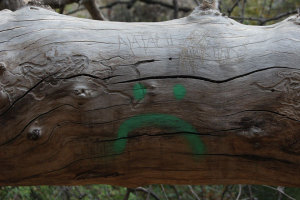
Puente Hills Preserve
|
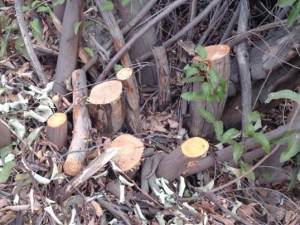 Chino Hills State Park Chino Hills State Park
|
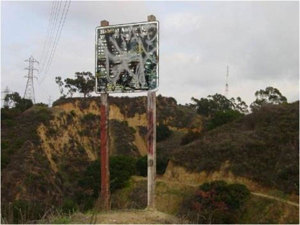 Turnbull Canyon Preserve Turnbull Canyon Preserve
|
| Creation of Illegal and Unsafe Trails |
| Visitors that create their own short cut on a switchback, up a hill, around a corner, or through a field are posing a risk to other park visitors. These photographs depict the resource impacts of illegal trail creation, but the risk is much greater (including personal injuries and the inability of emergency personnel to find you or an injured trail user). Cutting switchbacks cause erosion of the hillside and make it more unstable. Other times park visitors, such as the hikers in photo #2, have mistaken a wildlife trail for a park trail. Visitors should know that trails don’t have such steep inclines. When bikers gain speed going down hill it is easier to go around corners higher than it is to slow down and stay on the trail. These new unauthorized trails can cause enormous erosion problems and may be unsafe, steep, and slippery. If you are injured on an illegal trail, it will be harder for search and rescue personnel to find you. Your safety is most important, stay on designated trails only. (Click on the photo to enlarge) |

Puente Hills Preserve
|
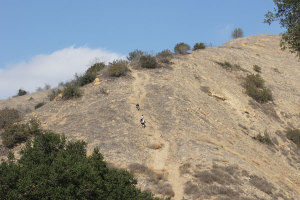
Chino Hills State Park
|
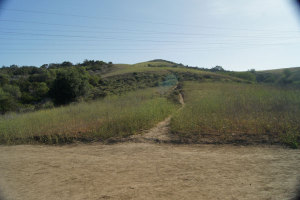
Powder Canyon Preserve
|
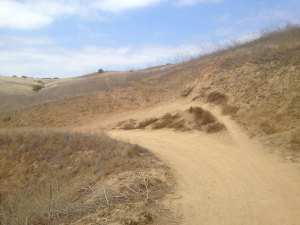
Chino Hills State Park
|
| Ignoring Trail Signage and Rules |
| To ensure the safety of all park visitors, everyone should obey all posted signs and rules. In these examples, recreational enthusiasts create unsafe conditions. In the first two photos, trail users tore down fencing and disregard posted trail closure signs. This causes unsafe conditions and perpetuates the problem. Other unsafe activities include smoking in our wildlands. We are in fire season year round. In most parks, there are “no campfire” and “no smoking” ordinances. Fighting wildfires is expensive and has the potential to destroy the park, homes, and lives. Don’t be careless. Finally, unsafe speeds puts you and others at risk. Even though speed can be picked up going down hill, all parks have posted speed limits for your safety and the safety of others. This unsuspecting hiker didn’t know that a mountain biker was speeding towards her. Trail etiquette calls for bikers to yield to hikers, not the other way around. Please obey all rules and posted regulations to keep you and others safe. (Click on the photo to enlarge) |
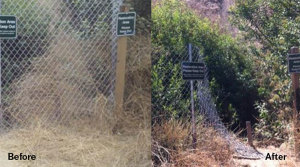
Turnbull Canyon Preserve
|
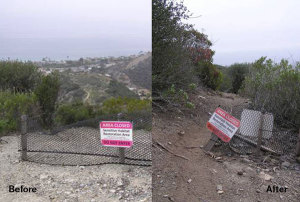
Hobo Aliso Conservation Area
|
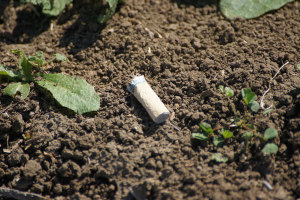
Chino Hills State Park
|
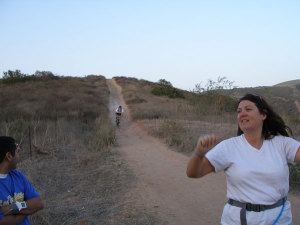
Peter’s Canyon Regional Park
|
| Littering and Illegal Dumping |
| Careless behavior in our parks perpetuates future poor behaviors. In these examples, trail users have used our natural areas as a place to throw their trash. From a high school track team leaving a mess behind at a trail head to throwing used water bottles into the vegetation. Don’t litter the trails. What you pack in, you should always pack out. At your next birthday party consider the impacts to the parks and wildlife when your helium balloon gets snagged in a tree or bush. Finally, this vehicle was found upside down and away from any main road. The parklands are here for all of us to enjoy, but without proper stewardship their resource values will diminish. (Click on the photo to enlarge) |
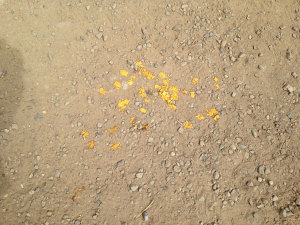
Chino Hills State Park
|
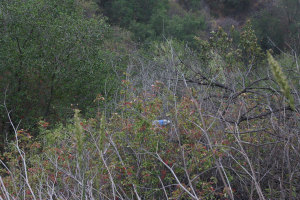
Puente Hills Preserve
|
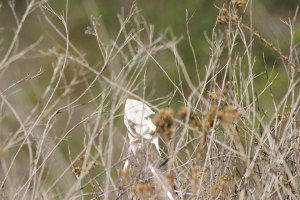
Chino Hills State Park
|
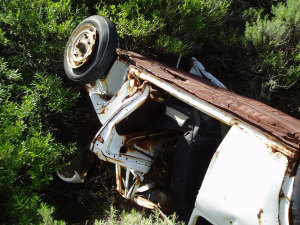
Cleveland National Forest
|
| Exposing Yourself to Increased Danger on the Trail |
| Safety on the trail and in our wildlands should always be a priority. This backpacker is standing very close to the edge of a waterfall that drops 100 feet below. The view is just as good from a few feet back. In the second example, the sign relays the story of two boys playing in the water downstream from Vernal Falls. They didn’t know the risks of being in the water. The price they paid was with their lives. Signs stated not to swim in the water and their mom said “they weren’t swimming,” they were wading in the water. Please take the most expansive definition of the signage to keep yourself and your children safe. It can be very difficult and costly to have search and rescue personnel attempt to find you in remote or wilderness locations. Stay safe. |
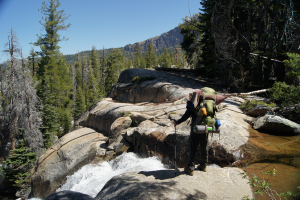
El Dorado National Forest
|
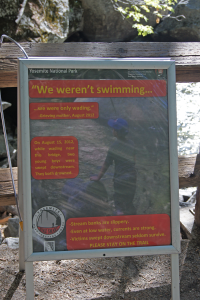
Yosemite National Park
|
|
|
| Wildlife and Habitat Impacts |
| Some activities knowingly and unknowingly have significant impacts on the wildlife. Though some land managers allow for hunting during certain seasons, rules dictate the types of firearms, allowable uses and locations. Know the rules about fire arms. When trails are cut, the soil erodes, exposing the rock and tree roots. The soil helps keep the trees upright and without it, the trees may topple requiring trail closures. Other impacts are as simple as hitting wildlife on a trail. The “whitish” area in the center photo #3 is a barn owl that was hit and killed on a trail. Roadkill of reptiles and amphibians are more common on trails than birds. Pay attention and stay on designated trails. When we leave trash on the trail, sometimes animals mistake it for food. This plastic bag was digested by a coyote and excreted in its scat (poop). If the trash doesn’t get digested, the animal will likely endure a painful death. Pick up after yourself. Finally, the resources in our natural areas are protected. This endangered plant, the big-leaved crownbeard (photo #5), is impacted significantly when trails are illegally cut through native habitat. In some instances, specific areas have restricted recreational use to protect endangered plants and animals. Finally, these resources are not meant for collection. Leave the plants and animals in the natural areas where they belong. |
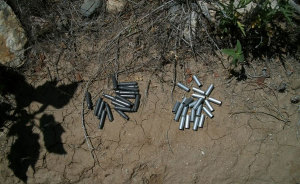 Murietta Hot Springs Preserve Murietta Hot Springs Preserve |
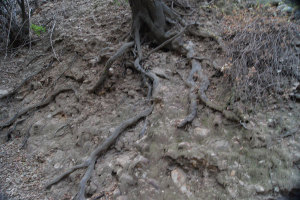 Hacienda Hills Preserve Hacienda Hills Preserve |
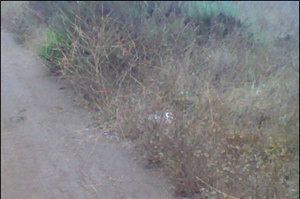
Santa Monica Mountains
National Recreation Area
|

Chino Hills State Park
|
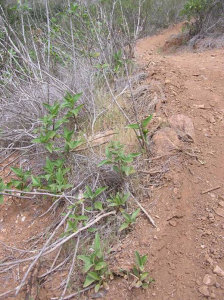 Hobo Aliso Conservation Area Hobo Aliso Conservation Area
|
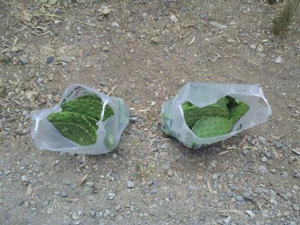
Puente Hills Preserve
|
| Inattentive, Uninformed, and Pre-Occupied Trail Users |
| Many people enjoy the outdoors but don’t realize the impacts they may have on the environment. Listening to music, like this trail runner leaves you vulnerable to approaching trail users, wild animals, and other potential dangers. With the introduction of social media, many trails and parking areas are overrun. In this instance, the use of Meet Ups and other social media channels is causing more and more people to arrive at trailheads simultaneously. Please know that most parks require a permit if you have above a certain number of trail users. In photo #3 bikers not only didn’t yield to the hikers, but they were on a hike and horse ONLY trail. Get an official park map and plan your route accordingly. Four bikers nearly collided with this coyote on a trail while going too fast around a blind corner. Remember, you are visitor in their home. Please be respectful, follow the speed limits and slow down around blind corners. Other times our cultural resources are impacted when illegal trails are used. These two mountain bikers was using an illegal trail and riding over protected cultural resources. Imagine if your ancestors were buried there and future generations trampled their remains. Once these resources are gone they are gone for good. There is no replacing them. |
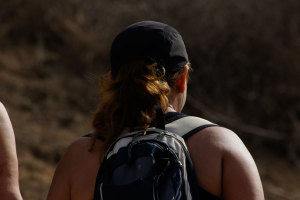
Chino Hills State Park
|
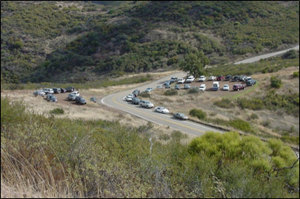
Santa Monica Mountains
National Recreation Area
|
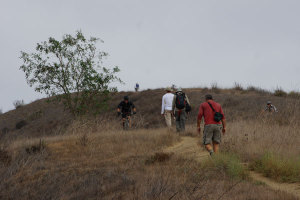
Chino Hills State Park
|
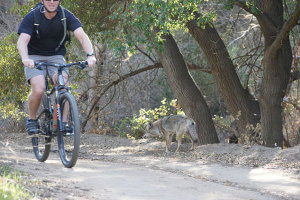
Chino Hills State Park
|
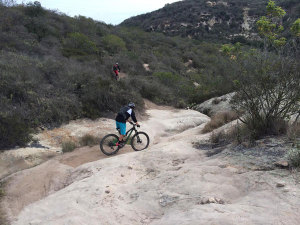 Laguna Coast Wilderness Park Laguna Coast Wilderness Park |
|
| Illegal Construction in Nature Areas |
| Parks are not your place to construct an adventure of your choosing. They are owned and operated by park managers with specific regulated activities. In these instances park visitors built a fort in a tree and bike ramps/jumps. None of this construction is a permitted activity. These ramps increase the liability of land managers and can lead to serious and dangerous accidents. Rangers must deconstruct these items taking their valuable time away from more important activities. |
|
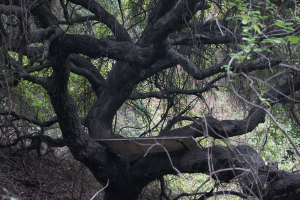 Hacienda Hills Preserve Hacienda Hills Preserve
|
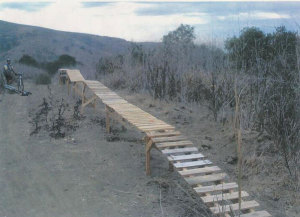
Turnbull Canyon Preserve
|
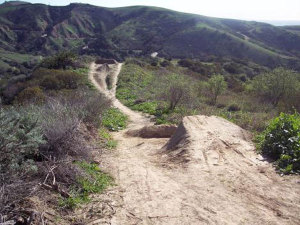
Santa Monica Mountains
National Recreation Area
|































